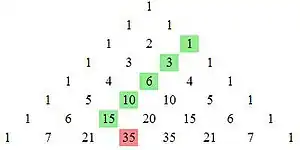Hockey-stick identity
In combinatorial mathematics, the hockey-stick identity,[1] Christmas stocking identity,[2] boomerang identity, Fermat's identity or Chu's Theorem,[3] states that if are integers, then

The name stems from the graphical representation of the identity on Pascal's triangle: when the addends represented in the summation and the sum itself are highlighted, the shape revealed is vaguely reminiscent of those objects (see hockey stick, Christmas stocking).
Formulations
Using sigma notation, the identity states
or equivalently, the mirror-image by the substitution :
Proofs
Generating function proof
We have
Let , and compare coefficients of .
Inductive and algebraic proofs
The inductive and algebraic proofs both make use of Pascal's identity:
Inductive proof
This identity can be proven by mathematical induction on .
Base case Let ;
Inductive step Suppose, for some ,
Then
Proof 1
Imagine that we are distributing indistinguishable candies to distinguishable children. By a direct application of the stars and bars method, there are
ways to do this. Alternatively, we can first give candies to the oldest child so that we are essentially giving candies to kids and again, with stars and bars and double counting, we have
which simplifies to the desired result by taking and , and noticing that :
Proof 2
We can form a committee of size from a group of people in
ways. Now we hand out the numbers to of the people. We can divide this into disjoint cases. In general, in case , , person is on the committee and persons are not on the committee. The rest of the committee can be chosen in
ways. Now we can sum the values of these disjoint cases, and using double counting we obtain
See also
- Pascal's identity
- Pascal's triangle
- Leibniz triangle
- Vandermonde's identity
- Faulhaber's formula, for sums of arbitrary polynomials.
References
- CH Jones (1996) Generalized Hockey Stick Identities and N-Dimensional Block Walking. Fibonacci Quarterly 34(3), 280-288.
- W., Weisstein, Eric. "Christmas Stocking Theorem". mathworld.wolfram.com. Retrieved 2016-11-01.
{{cite web}}: CS1 maint: multiple names: authors list (link) - Merris, Russell (2003). Combinatorics (2nd ed.). Hoboken, N.J.: Wiley-Interscience. p. 45. ISBN 0-471-45849-X. OCLC 53121765.